
Palm trees, tropical beaches, pleasant sunny conditions, and lovely landscaped gardens are all synonymous with one another. The fan-shaped or feathery fronds (leaves) and fiber-covered trunks or stalks of palms are what distinguish them from other plants. Palm trees thrive in warm nations, such as date and coconut palm trees. However, temperate climates and cold temperatures are tolerated by certain palm species. Indoor palm tree houseplants may be found in a few different varieties.
The Arecaceae family of plants includes palm trees, which are a kind of evergreen plant. Palm trees come in over 2,600 species and are divided into more than 200 genera. The branchless stalks and lovely big evergreen leaves distinguish palm trees.
Palms grow in a variety of shapes and sizes. Coconut palms with their long thin leaves, for example, may reach a height of over 100 feet (30 meters). Delicate sweet date palms may reach a height of 75 feet (22 meters).
Just 6 to 9 feet (1.8 – 2.7 m) tall, certain little palm trees make ideal garden plants. Dwarf palm tree plants, in particular, are suitable for indoor cultivation in containers.
You’ll learn about palm tree variations such as big, little, dwarf, and indoor trees in this article. You’ll discover the picture and common name of each kind of palm tree, as well as how to distinguish them. This will help you decide on the ideal palm for your garden or at home.
Palm Tree Facts

Palm trees are grown for their decorative qualities as well as for products made from them. Coconuts, for example, are harvested for their meat, fibrous husks, and oil from palm trees. In Mediterranean and Middle Eastern nations, date palm trees are widespread. Palm oil (palm oil) and wood are used to make wicker furniture, which is another reason why palm trees are grown.
The tallest palm trees in the world belong to several species. The Wax Palm in Colombia can grow to be 200 feet (60 meters) tall, despite the fact that it does not grow as tall as Californian sequoia trees. These trees grow to be as big as a 25-story skyscraper!
Palm trees aren’t always trees, though. Shrub-like evergreen plants and climbing palms are among the over 2,600 different palm species.
Palm Tree Identification

The unusual form of the palm fronds (leaves) is frequently used to identify palm tree species. Palm tree leaves are often pinnate (feather-like) or palmate (fan-like fronds) in appearance.
The shape of the trunk can also be used to identify the type of palm tree. Long slender single trunks are seen in some of the tallest palm tree species, while short fat palm trunks are seen in dwarf varieties. The trunks of certain tiny palm tree species may be grouped together into clusters of three or four. There are also a few dwarf palm trees with bushy pinnate fronds that extend from the ground, with no trunks.
Small Types of Palm Trees (Including Dwarf Palm Trees) – With Pictures
The majority of individuals who want to cultivate palm trees in their garden choose tiny or miniature palm species. Micro or tiny palm trees are usually identified as measuring less than 12 feet (3.6 meters) in height, which is quite small in comparison to palms. Bushy palm trees and tiny palm trees are two sort of palm trees found within the tiny or dwarf palm tree group.
The most frequent types of small, dwarf and bushy palm trees can be found below.
Cat Palm (Chamaedorea Cataractarum)

The slender pinnate dark green leaves of the cat palm plant grow on thin stems that protrude straight from the ground, making it a tiny palm plant. Outside, this 6-foot (2-meter) tall trunkless palm tree grows, while indoors it only grows to 3 feet (1 meter). The clumping palm develops a dense thicket of glossy thin leaves over time.
The narrow green stems and pinnate leaves, trunkless development, and flowering yellow ball-like blooms are all identifiable features of a cat palm. Little glossy green palm fruits develop that turn black ovoid-shaped drupes 0.5″ (1.25 cm) long when the palm is pollinated.
Pygmy Date Palm (Phoenix roebelenii)

The pygmy date palm is a tiny-sized palm tree with the common name that it bears. This palm is a genuine member of the Arecaceae family and grows no higher than 10 feet (3 meters). The solitary stem of the tiny palm tree, which has bushy pinnate fronds that grow to be around 3 feet (1 meter), may be recognized.
For subtropical landscaped gardens, this palm species is an superb decorative flowering tree. Pygmy date palm’s arching-drooping fronds dwarf the spiky-looking timber and practically conceal it. Container-grown short palm trees are also a good option.
Pindo Palm (Butia capitata)
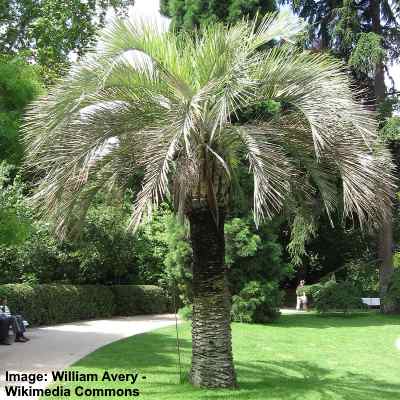
Pindo palm trees are a cold-hardy palm species that is also known as the jelly palm. Mature palms are a slow-growing palm species that may grow to be 15 to 20 feet (4.5 – 6 meters) tall. This implies that they are appropriate for small palm tree gardens.
These small palm plants are adapted to most soil types and flourish in full sun or partial shade. The palm is distinguished by its crimson, yellow, or white blooms, which are a light orange to brown color. The fruit of the palm trees is used to make jelly.
Triangle Palm (Dypsis decaryi)

The Dypsis decaryi palm, which is classified as a small to medium-sized palm tree, is known by the common name Triangle Palm. The pinnate fronds of the Triangle palm, which may reach 8 feet (2.5 meters) in length, are easily identified. The fronds’ leaflets point out at a 120° angle, giving them a triangular cross-section on the cross-section, which is an interesting feature.
You may see another reason why this palm tree is called the triangle palm if you look at pictures of it. A single fibrous stem supports the leaves, which spread out into a distinct triangle. For subtropical and tropical gardens, this is a highly decorative kind of palm tree. As a backyard tree, the Triangle palm is ideal.
Mediterranean Dwarf Palm (Chamaerops humilis)
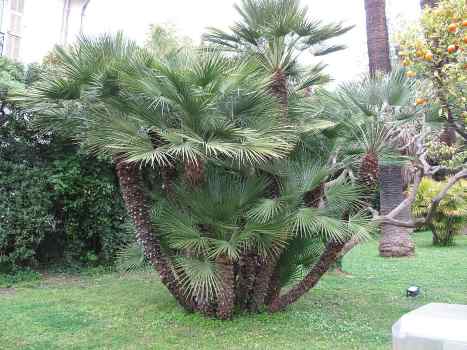
This little-growing tree is also known as the European Fan Palm. The palm of the Mediterranean Dwarf Palm (Chamaerops humilis) has a cluster of trunks that give it the appearance of a shrub rather than a tree. This tiny palm grows to around 10–20 feet (2–5 meters) tall in warm climates.
The fan-shaped palm fronds are light green to silver in hue and grow in a fan pattern. Each leaf is up to 5 feet (1.5 meters) long and is 20 to 30 inches (50 to 80 centimeters) wide.
The decorative worth and cold hardiness of the Mediterranean Dwarf palm are highly valued. The palm can survive temperatures as low as 10°F (−12°C) and thrives in the hot sun. Even if you live in temperate climates, the elegant palm can give your gardens a tropical appearance.
Mazari Palm (Nannorrhops ritchiana)

Rather than a palm tree, the Mazari palm is a shrubby bush. The Mazari palm is a palmate (fan-like) leafed plant that grows in clusters of stems and is native to southern Asia. Between 1 and 4 feet (30 and 120 cm) long, the fan-shaped leaves may be found.
The palm’s other distinctive feature is its color, which is distinguished by the striking appearance of its leaves. The long tapering leaflets give the palm a spiky appearance, and the fronds are silvery-green or silver-blue in color.
The Mazari palm, like other cold-hardy palm trees, requires hot summers to flourish. This species, on the other hand, is cold-tolerant down to 10°F (−12°C).
Dwarf Majesty Palm (Ravenea hildebrandtii)
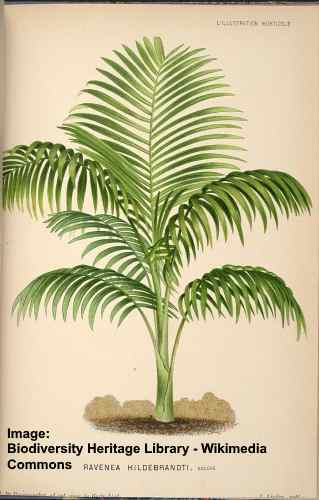
The Dwarf Majesty palm tree (Ravenea hildebrandtii) is one of the most popular short palm trees for gardens and landscaping. The dark green pinnate leaves of this single-trunk palm The palm tree can only reach a height of 8 feet (2.4 meters) due to its slender trunk and 3 inches (7 cm) thickness.
In any subtropical ornamental garden, the huge broad arching leaves stand out as a focal point. The stem of the bright green leaves can have up to 100 leaflets and can grow up to 3 feet (100 cm) long. Every garden can benefit from the slender trunk and broad crown of leaves. This palm may also be cultivated in pots.
One of the best potted palm trees for outdoor cultivation is the Majesty palm.
Christmas Palm Tree (Adonidia merrillii)

The Christmas palm (Adonidia merrillii) is an excellent option if you’re looking for a miniature palm tree for your garden. As compared to other towering coconut or date palms, this decorative palm tree is tiny. The Christmas palm tree is said to be one of the most popular decorative palm types on the planet, according to certain sources.
While this tiny palm tree only grows to a height of 25 feet (7.6 meters), some smaller varieties only reach 15 feet (4.5 meters). A lovely crown of green foliage is formed by large pinnate palm leaves arching up from the top of the stem.
Bottle Palm Tree (Hyophorbe lagenicaulis)
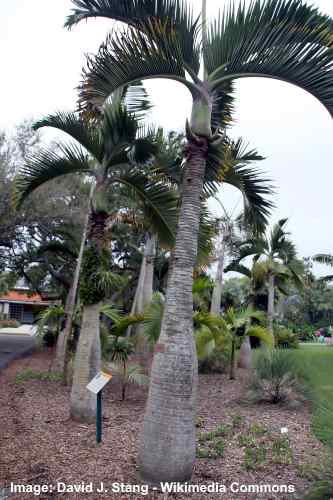
The bottle-like form of the small fat trunk gives the Bottle Palm tree its name. The enlarged trunk at the base of this little palm tree is what distinguishes it. This distinguishes this palm from the Spindle palm, which grows in the middle of the fat trunk and swells.
Three or four enormous palm leaves rise from the top of the 10 foot (3 m) tall tree. Pinnate leaves with leaflets 2 ft. (0.6 m) long may reach a length of 12 feet (3.6 meters) when fully grown.
In places like Florida and California, these bottle palms flourish. You may also cultivate them indoors throughout the winter and then move them outdoors.
Sago Palm (Cycas revoluta)

The Sago palm, despite its name, is not a true species of palm tree. The family Cycadaceae, which includes the Sago palm, is botanically distinct from palms. The short trunk and fern-like new leaves of this palm distinguish it.
Red Sealing Wax Palm / Lipstick Palm (Cyrtostachys renda)

The crown shaft and leaf sheaths of the red sealing wax palm are clearly visible. This flowering palm species may reach 10 – 20 feet (3 – 6 meters) in height, also known as the red palm. Its pinnate leaves are greenish, and its blooms are dark blue-black. Its fruits are black. The stems of mature red palms are striking green and red.
The red sealing wax plant stands out in landscapes due to its scarlet crown shaft and brilliant red leaf stalks. USDA zones 10 and 11 are ideal for growing the lovely palm. Nonetheless, you may grow this red palm in pots indoors if you want to admire its magnificence.
Arikury Palm (Syagrus schizophylla)

Arikury palm trees feature arching olive to dark-green fronds that form a spreading crown and are a small decorative palm tree. Since it doesn’t grow taller than 6 feet (1.8 meters), this popular accent palm is ideal for small gardens. The 4 to 6-foot (1.2 to 1.8-meter) leaves are evergreen and palmate.
The arikury palm, which has arching, flat leaves and on extremely long jagged petioles, is suited for subtropical landscapes in USDA zones 9 to 11. Palm blooms feature delicate yellow petals on strong arching, drooping stems that may be up to 3 feet (1 meter) long.
Other Types of Palm Tree (With Pictures and Names)
There are numerous sorts of tall palm trees that stand out in subtropical and tropical gardens, depending on your climate and the kind of garden you have.
Coconut Palm (Cocos nucifera)

One of the most well-known palm species is the coconut palm tree. With a grayish-brown, somewhat bent smooth trunk and 15–20 ft. (4.5–6 m) long screening palm fronds, this large palm tree grows to 100 ft. (30 m) tall.
The coconut fruit, sometimes known as the “taste of paradise,” is a huge green or yellow when it’s immature. A hairy fiber protects the visible mature brown coconut seed, which is encased in a thick husk. The white meat inside the wood-like shell is the edible part of a coconut.
A coconut palm tree may yield up to 75 fruits every year. Near the central stem and among the leaf stems, thick, spherical fruits develop in bunches.
Coconut palm trees thrives on sandy, salty soils and are commonly found on the coast. Coconut palms may be found growing along beaches, streets, and parks in southern states and tropical countries.
If you don’t have enough space for a towering tropical palm in your yard, there are several dwarf coconut palm tree varieties. The ‘Malayan Dwarf’ is an example of a dwarf coconut landscape palm that does not grow taller than 5 feet (1.5 meters).
Coconut palms are difficult to grow successfully even if you can grow them indoors. If you want an evergreen leafy tropical houseplant plant, areca palms are usually easier to grow indoors.
Date Palm Tree (Phoenix dactylifera)

Due to its abundant clusters of delicious dates, the date palm tree is one of the easiest palm trees to identify. Additionally, the towering feathery fronds of beautiful palms may grow up to 20 feet (6 meters) long, and clusters of brown, red, or yellow fruits may be seen on their crowns.
Tall date palm trees grow to be 70 to 75 feet (21 to 23 meters) tall. The spiny leaf stalks may grow up to 20 feet (6 meters) long on some plants. The huge leaves feature up to 150 12-inch (30 cm) long leaflets. The magnificent light green crown of the date palm might range from 20 to 30 feet (6 to 10 meters) wide.
The delicious sweet sticky fruits of date palm trees, which are a kind of drupe, are best known. The dark brown oval fruits with wrinkles skin are the most common form. Other date palm types, on the other hand, may yield deep red, black, yellow, or golden yellow clusters of dates.
California Fan Palm (Washingtonia filifera)
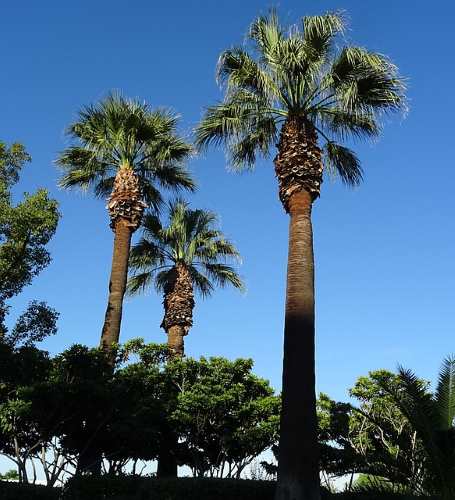
The California fan palm has long, fan-shaped fronds with fibrous threads and a sturdy columnar trunk. It is a medium-sized ornamental palm tree. The California fan palm’s distinctive leaves, which are composed of waxy green blades that spread out in a fan pattern, are a distinguishing characteristic.
This palm tree grows between 40 and 60 ft. (12 – 18 m) tall.
The grayish and tan trunk of the California fan palm, which stands upright, is another identifying feature. Moreover, the skirt-like form of dead fronds at the crown of the tree makes it simple to distinguish California palms. The leaves droop down and turn brown after the gray-green leaves die.
The thread-like strands on the green palmate leaves are referred to by its botanical name, Washingtonia filifera.
Chilean Wine Palm (Jubaea chilensis)

The thick, columnar, smooth gray trunk, long arching feather-like green fronds, and stunning crown distinguish the Chilean wine palm as a tall palm tree. The thick, straight stem of this hardy palm, which can grow up to 3 feet (1 meter) in diameter at the base, is a distinguishing characteristic.
The Chilean wine palm grows 60 to 80 feet (18 to 24 meters) tall and is regarded as one of the world’s most magnificent palm trees. Palmate fronds 15 feet (4.5 meters) long make up the thick, upward growing crown. This palm species has a smooth gray trunk, unlike the fibrous trunks of many other palms. In addition, throughout the summer, minute purple and yellow flowers bloom on the palm, adding to its elegance and loveliness.
The palm has a stumpy appearance with an explosion of large arching fronds when it is still in its juvenile stage. Since the palm grows at a snail’s pace, it may take many years to reach its full height.
This solitary-trunked palm tree is cold hardy and will grow in temperate regions, despite its Chilean origin. In Ireland, Northern and Southern California, and South Africa, you may see Chilean wine palms growing. Honey palm, palm honey tree, and Chilean coquito palm are all popular names for this plant.
Florida Royal Palm (Roystonea regia)

A magnificent palm tree with a towering, smooth, very slender gray-white trunk, an arching dark green frond crown, and rounded red or purple-black palm fruits, the Florida royal palm is a spectacular tree. The smooth green crownshaft, bulging stem base, and upright 65 to 100-foot-tall trunk are all identifying characteristics of this palm tree.
The crown of the palm is made up of 15 13-foot-long (4-meter) arching fronds. Late in the spring, little pinkish-white blooms bloom. The palm tree produces round drupes 0.6″ (1.5 cm) long and 0.4″ (1 cm) wide after pollination. The bushy crown and slender, smooth stem evoke images of tropical scenery
The unusual growth habit of shedding its old fronds distinguishes this smooth, tall Florida palm. The crown is covered with dead leaves that peal off to reveal a lustrous green trunk. In Florida, Texas, Southern California, and Hawaii, this decorative street palm may be found. Cuba’s national tree is Roystonea regia.
Açaí Palm (Euterpe oleracea)
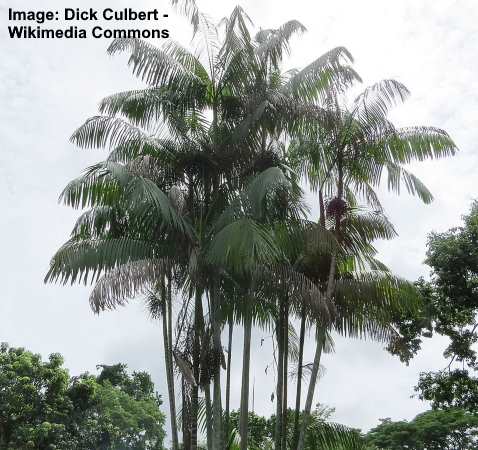
A skinny palm tree with multiple clustering stems that may grow up to 65 feet (20 meters) tall, the acai palm tree is a popular choice. The acai palm is distinguished by its pinnate leaves, which may grow up to 10 feet (3 meters) long and 1 inch (2.5 centimeters) in diameter.
Acai palms grow in swamps and floodplains in South America, where they are native. The acai palm’s berries are the most valuable feature. The little black drupes that adorn drooping branches are called acai berries. A single bunch of 500 to 900 fruits is common.
Peach Palm (Bactris gasipaes)
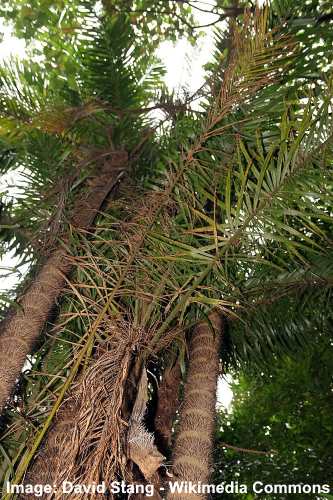
The fruit-producing peach palm tree has clusters of crimson palm fruits. Around 66 feet (20 meters) tall, peach palms with their crimson fruits grow. The pinnate fronds on the multi-stemmed thorny tree are 10 feet (3 meters) long and spiky.
Peach palms, also known as edible palm fruit, are a kind of tall clumping palm tree. The red pulpy palm fruits are the most common. However, yellow or orange peach-like fruits may be found on other types of peach palm.
A peach palm’s spiny trunk is a fundamental identifying feature. The slender stem is roughly 10 to 25 centimeters in diameter. The palm tree, on the other hand, has thorns in circular bands around the brownish-gray trunk, as seen in photos taken up close.
Oil Palm (Elaeis guineensis)
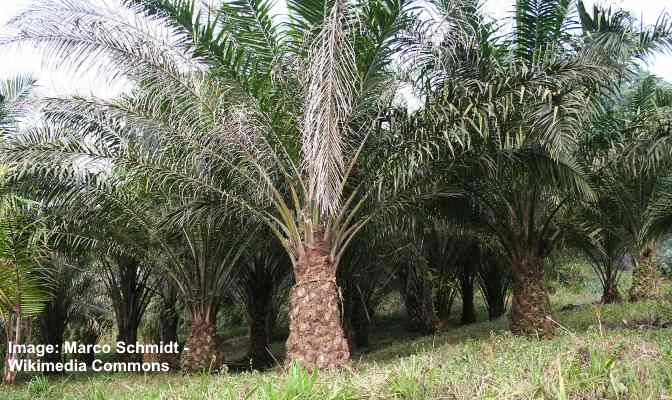
The oil pressed from the fruit of the oil palm is famed. Oil palm trees have huge pinnate fronds that may reach 10 to 16 feet (3 to 5 meters) in length and may grow up to 66 feet (20 meters) tall. The fruit of the tree, which is about the size of a plum, grows like red palm berries.
A solitary-stemmed palm tree with a fruit called oil palm. The ornamental tree has a vase-shaped appearance due to the beautiful palm leaves that grow in an upwards, arching habit. The massive clusters of 200 to 300 red palm fruits near the stem are what distinguish this palm from others.
A palm fruit is an oblong drupe with an egg shape that measures up to 1.4″ (3.5 cm) long and 1″ (2 cm) wide. Palm oil is made from the greasy pulp, while palm kernel oil is marketed as a liquid.
Foxtail Palm (Wodyetia bifurcata)
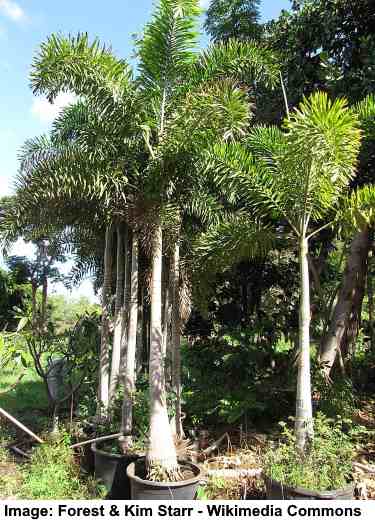
The foxtail palm tree’s enormous arching or curled fronds, which may be up to 10 feet (3 meters) long, make it a magnificent medium-sized palm. The plume-like foliage of the ornamental palm, which resembles a bushy fox’s tail, is what distinguishes it.
The foxtail palm’s large egg-shaped orange palm fruit is another identifying characteristic. The oval fruits turn olive green and mature to an orange or scarlet color before growing 2” (5 cm) long.
Because of its self-cleaning tendency, the foxtail palm is a sort of smooth palm tree. The light-gray to white trunk of the palm tree grows to 30 feet (10 meters) tall. Dead fronds fall from the crown, exposing a smooth green stem, similar to that of the Florida royal palm. Distinctive rings surround the gray trunk of the palm tree bark are visible up close.
Guadalupe Palm (Brahea edulis)

The Guadalupe palm tree has fan-shaped leaves on its stems, a rough, brown fibrous solitary trunk, and sweet black palm fruits. It is a small palm plant with fan-shaped leaves. The Guadalupe palm, a slow-growing palm species, grows 15 to 40 feet (4.5 to 12 meters) tall.
The stiff leaves that grow in the form of a fan at the end of long smooth stems are a distinguishing characteristic of the Guadalupe palm. Because of the spiky appearance of the thick crown, these palm trees create a dramatic statement in the landscape. As a consequence, the ornamental palm tree is becoming more common in California’s landscaping.
The aromatic, creamy yellow blooms of Guadalupe palms emerge amid the foliage in the summer and may be identified. The palm produces delectably sweet palm fruits after blooming, which you may eat right away or utilize in cooking.
Bismarck Palm (Bismarckia nobilis)
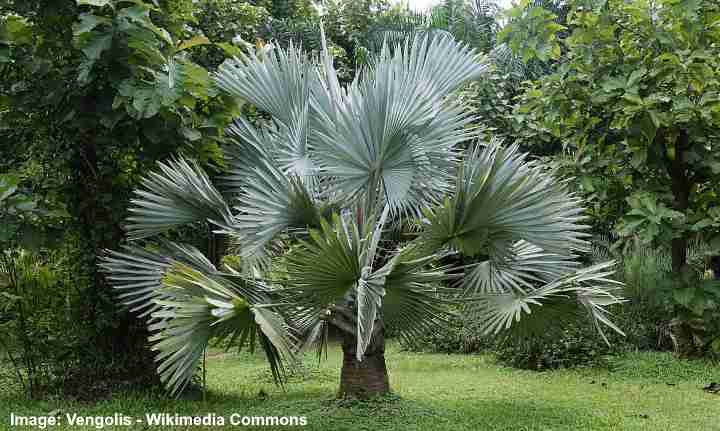
Due to its enormous steely-blue or silvery gray spiky leaflets, the Bismarck palm is an immediately distinguishable palm. The 20-foot (6-meter) tall and 24-foot (7.5-meter) wide fan-shaped palm leaves grow in all directions, giving the plant a magnificent pale green spherical crown. The palm’s visual attractiveness is boosted by its robust, short trunk.
The silvery-blue leaves, which may be up to 10 feet (3 meters) broad, have a spiky decorative appearance. In gardens and parks, this slow-growing palm tree grows up to 40 feet (12 meters) tall. In Florida, Southern California, Texas, and Arizona, it’s a popular landscaping palm.
Proctor’s Silver Palm, Cayman Thatch Palm (Coccothrinax proctorii)
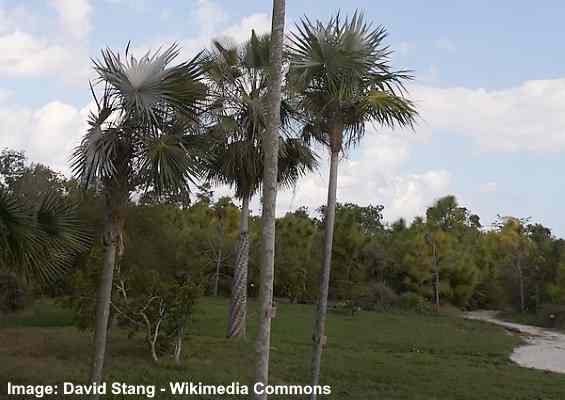
A medium-sized palm tree with a solitary slender stem and black green fronds, the Proctor’s silver palm has a symmetrical crown. The tropical palm tree grows to be between 10 and 20 feet (3 and 6 meters) tall. The trunk of the magnificent palm tree gradually becomes smooth and gray as it ages.
The islands of Central America are home to cayman thatch palms. Palm trees that grow in tropical or subtropical climates have distinctive fan-shaped leaves. Cayman thatch palm crowns also have an open, rounded, or triangular shape. You can use the palm as an attractive landscaping plant or specimen tree because it grows slowly.
MacArthur Palm (Ptychosperma macarthurii)

The MacArthur palm tree, which can grow up to 33 feet (10 meters) tall, is a slender majestic palm tree. Because of its clumping habit, slender, smooth trunks, green crownshaft, and rounded spiky crown, the MacArthur palm is simple to recognize in the landscape.
The palm leaves of MacArthur have 30 to 80 leaflets that are 22 inches (56 cm) long and can be up to 10 feet (3 meters) long. The slender palm tree has a distinct appearance of tropical landscapes because of the thick palm crown, which may have 3 to 13 fronds.
In the landscape, MacArthur palms grow as multi-stemmed palm trees, making them easily identifiable. Other identifying traits of the palm are a whitish trunk with dark rings, clusters of yellowish-green flowers, and bunches of small bright red fruit.
Canary Palm Tree (Phoenix canariensis)

Canary palm tree (Phoenix canariensis) is one of the most beautiful palms you can cultivate. The massive pinnate leaves that emerge from the top of towering palm trunks distinguish the palm tree.
Canary palms may grow to be 33 to 66 feet (10 to 20 meters) high depending on the climate. The tall, dark-green leaves create a beautiful crown that measures 13 to 20 feet (4 to 6 meters). Canary palm trees, which are a kind of palm tree from the Phoenix genus, produce edible dates as well.
Sylvester Palm Tree (Phoenix sylvestris)
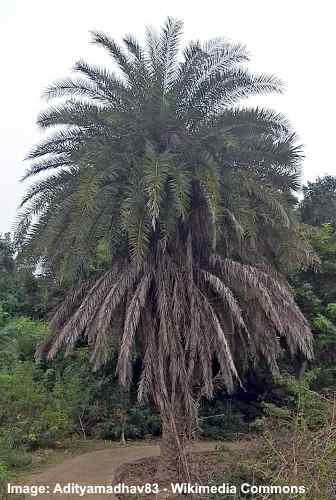
The Sylvester palm tree (Phoenix sylvestris) is related to the Canary palm tree. India, Pakistan, and Nepal are all home to this date-producing palm tree. The Sylvester palm reaches heights of up to 50 feet (15 meters) and may be as short as 13 feet (4 meters). The apex of this single long stem is adorned with large arching pinnate leaves.
Chinese Fan Palm (Livistona chinensis)
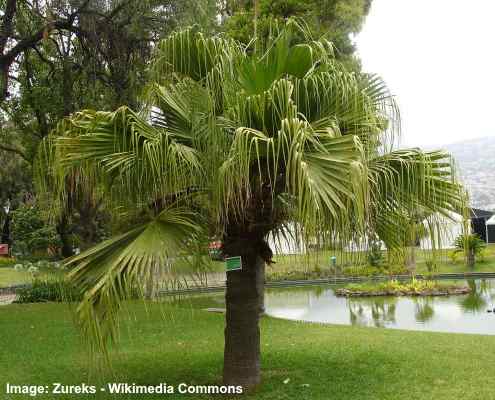
The Chinese Fan palm (Livistona chinensis), a solitary-stemmed palm with delicately drooping leaves, is native to Asia and the Far East. The fan-shaped (palmate) leaves give the palm its name. These sprawl from the top of 30 to 50-foot-tall (9 – 15 m) stout stems. The tree may grow up to 12 feet (4 meters) wide.
Palmetto Palm Tree (Sabal palmetto)

Palmetto palms belong to the Sabal genus and subfamily Coryphoideae, which includes tall-growing, elegant palm trees. The distinctive spiky-leaved fan shape of Sabal Palmetto palms distinguishes them. These tall palm trees’ straight thick trunks stretch up to 65 feet. The height is 20 meters (tall).
Palmetto palms are the official tree of South Carolina and Florida, hence if these trees make you think of beaches, it’s because they are.
One of Florida’s most popular palm tree species is the palmetto palm, which is native to the state.
Mexican Palm tree (Washingtonia robusta)

The Mexican Fan palm, or Washingtonia robusta, depicts the leaf form of this sort of palm tree, which has a long slender stem and bushy leafy foliage at the top. Palmate leaves, which are fanned like a palm tree and may reach 3.3 feet (1 meter) in length, sit delicately on top of the 82-foot tower. The stems are 25 feet tall.
On this date palm, clusters of delicious fruit develop, although the fruit aren’t as tasty as those from other varieties.
Windmill Palm Tree (Trachycarpus fortunei)
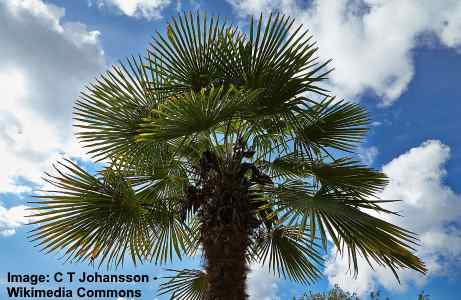
One of the hardiest palm species is the windmill palm tree, which is native to China and Japan. Long slender trunks may reach 66 ft. (20 m) tall on this evergreen perennial palm tree. This tall palm tree has fan-shaped leaves, a rough trunk, and a wispy palm appearance.
King Palm / Bangalow palm (Archontophoenix cunninghamiana)

The gorgeous crown of brilliant green fronds, grayish bark, pink blooms, and clusters of lovely red dates identify the King Palm Tree as a stunning palm. In tropical and subtropical regions, the king palm thrives. The crown of the palm tree, which consists of 15 to 20 broad arching fronds, is attractive.
The tall palm tree may reach 65 feet (20 meters) in height and is sometimes known as the Bangalow palm or Illawara palm. Its 15-foot-long (4.5 m) thick evergreen fronds consist of 150 leaflets that are 6″ to 12″ (15 – 30 cm) long and may be up to 15 feet (4.5 m) long. Rows of rings go up to the smooth greenish-brown crown-shaft, as they do on other palms.
Red Latan Palm Tree (Latania lontaroides)
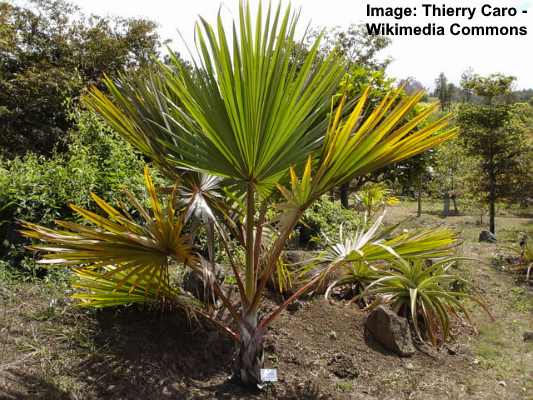
The latan tree, also known as the red latan, has a spiky appearance. Moreover, the fan-like fronds of this tropical palm tree are made up of stiff, prickly leaflets. The palm tree fronds are 8 feet (2.4 meters) broad, giving it a stunning, circular crown with a 20-foot (6-meter) reach.
Clusters of yellow spring blooms, brownish-green drupes 2″ to 3″ (5 – 7.5 cm) long, and a slender grayish stem with light rings surrounding it are additional features that help identify the red latan palm.
Fishtail Palm (Caryota mitis)

The fishtail palm is a magnificent multi-stemmed palm tree with light, glossy green leaves that resemble a jagged fish’s tail. Large deltoid leaflets sprout on long stems, creating thick layers of ruffled fronds. The clumping palm tree grows to be 40 feet (12 meters) tall and broad.
The fishtail palm produces beautiful creamy-white blooms and deep red fruits in addition to its immediately recognized bipinnate fishtail leaves. Unfortunately, Fishtail palm drupes contain deadly toxins and should not be consumed.
The palm fronds may grow to be 10 feet (3 meters) long and are glossy. The weeping appearance of the palm tree is due to the ruffled fishtail compound leaves that grow on long stems.
Montgomery Palm (Veitchia arecina)

The arching fronds and drooping leaflets, greenish-white flower clusters, and oval red fruits distinguish the Montgomery palm, which is a tall solitary palm tree. The look of tropical places is seen in Montgomery palms. This palm is distinguished by its straight, slender trunks and beautiful spreading crown at the end of a smooth pale green crown-shaft.
Montgomery palms may grow to be 80 feet tall (24 meters). The lanceolate drooping leaflets on the stiff, arching fronds grow up to 10 feet (3 meters) long. In the spring, clusters of greenish-white blooms 3 feet (1 meter) long appear at the base of Montgomery palms’ crown shafts. Bright yellow or crimson blooms emerge on pendulous stems after flowering.
Puerto Rican Thatch Palm (Coccothrinax alta)
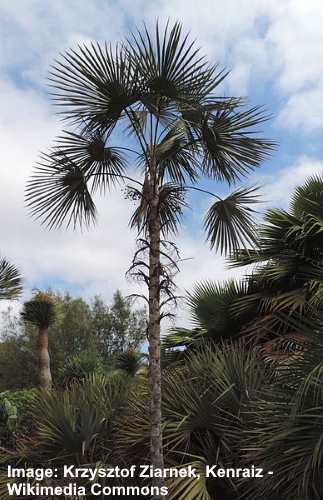
The solitary naked trunk of the Puerto Rican thatch palm is an extremely tall palm. The palmate leaves of the thatch palm, which form an open crown, are a distinguishing characteristic. The palm fronds are 5 feet (1.5 meters) wide.
The yellow blooms of the Puerto Rican thatch palm turn to purple-black fruits 0.23″ to 0.47″ (6–12 mm) in diameter after they bloom. The upright stem, which grows to be around 50 feet (15 meters) tall, and the sparse crown make the palm easy to spot in a tropical setting.
Everglades Palm (Acoelorrhaphe wrightii)
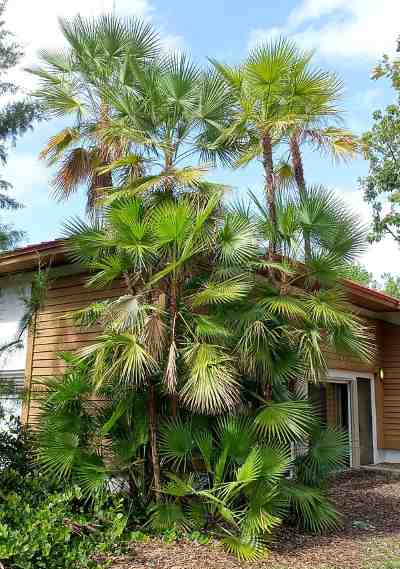
With big palmate, fan-shaped leaves, the everglades palm is a native Florida palm tree. The arching stems, with huge fronds up to 2 feet (0.6 meters) broad and 18 inches (45 centimeters) long, are used to identify the palm. On marshy, salty soils and full sun, the slow-growing everglades palm tree thrives.
In USDA zones 9 through 11, the everglades palm thrives. The palm tree grows to 20 to 30 feet (6 – 9 meters) tall and has a spreading canopy up to 25 feet (7.5 meters) broad at the top of a thin stem in a sunny environment. The tree’s beauty is further enhanced by its attractive fan-shaped leaves, which have a silver underside.
Saw Palmetto (Serenoa repens)

Saw palmetto has a mass of fan-shaped palmate fronds emerging from spined petioles and grows in multi-trunked clusters. The palm leaves are 3 feet (1 meter) in diameter and waxy. There are 18 to 30 pointed segments per bluish-green or emerald-green leaflet. Fragrant, creamy white flowers bloom on the palm as well.
Palmetto thrives in USDA zones 9 to 11 and is a native Florida palm tree. It can endure brief periods as low as 20°F (-6°C) and is a kind of cold-hardy palm. The palm is a valuable landscaping palm tree because of its spreading habit, thick leaves, white blooms, and yellow berries.
Queen Palm (Syagrus romanzoffiana)
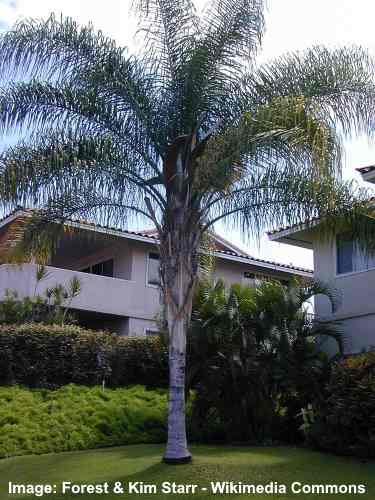
The queen palm, with its super-long arching fronds, is a beautiful evergreen tree. The feathery fronds grow on the top of a slender, smooth, gray stem and are up to 15 feet (4.5 meters) long. The queen palm produces creamy-white flowers in the spring and clusters of yellowish-orange edible dates, among other characteristics.
The queen palm, which grows up to 70 feet (21 meters) tall, is a sun-loving, heat-loving species. This fast-growing palm is cold-hardy to 25°F (-4°C), despite thriving in the tropics. The graceful palm tree has moderate salt tolerance and thrives in damp, acidic soil.
Texas Sabal Palm Tree (Sabal mexicana)
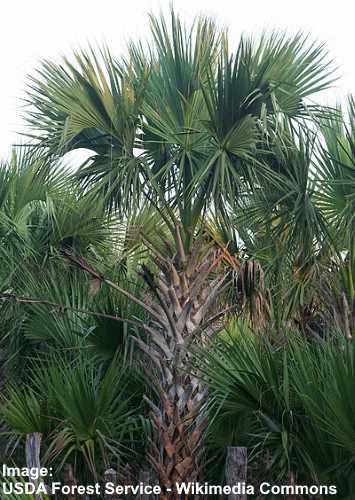
The Texas sabal palm is a robust native palm tree with a single trunk and large fan-shaped evergreen leaves that are also known as the Texas palmetto. The lush green palm fronds, which grow on 15-foot (4.5-meter) stems and create a dense, rounded crown, can reach up to 6.5 feet (2 meters) broad. Clusters of creamy white blooms and showy, black drupes are also characteristics of the sabal palm tree.
The sabal palm tree may reach a height of 50 feet (15 meters) and a spread of 25 feet (7.6 meters). Sabal palms grow well in high humidity, loamy, well-drained soils, and full sun and are suitable for growing in zones 8 to 11. To add visual appeal to garden landscapes, plant as a specimen tree.
Dwarf Palmetto Palm Tree (Sabal minor)

Central Texas and northeastern Mexico are home to the dwarf palmetto palm. The fan-shaped leaves of the flowering evergreen palm tree, which may grow straight from the earth, are what distinguish it. Its leaves, which are 3 feet (1 meter) broad and have smooth, spineless petioles, have big, pointed segments.
In zones 7 through 10, dwarf palmetto palm trees are drought and salt tolerant. The 4 to 5 foot (1.2 – 1.5 m) tall and broad shrub-like tree has a low growth rate. Because of its attractive character, it may be used as a foundation plant or texture accent in warm areas.
Needle Palm Tree (Rhapidophyllum hystrix)

The needle palm, which grows between 3 and 6 feet (1.8 and 1.8 meters) tall, is a cold-hardy shrub-like palm tree. Its 3 ft. (1 m) wide leaves have up to 12 stiff, slender segments that create an open fan shape, and they are glossy and lustrous.
In USDA zones 6 through 10, the needle palm is one of the hardiest palms. The palm is a versatile landscaping plant because of its dense foliage and slow growth. In addition, full sun and deep shade support the growth of the shrubby palm.
In a shade garden, foundation planting, border plant, or container plant, you may utilize the decorative palm as an evergreen ground cover.
Indoor Palm Trees (With Pictures and Names)
Several kinds of decorative palm trees, if used indoors, may provide bright foliage. In conservatories, certain kinds of indoor palm plants may be maintained in containers. Indoor palm tree plants ‘miniature’ or ‘baby’ size makes them a suitable addition to your houseplants, and they flourish in many environments.
Here are some types of palms that grow well indoors.
Parlor Palm

The evergreen perennial known as the Parlor Palm has the botanical name Chamaedorea elegans. Reed-like slender stems with light-green pinnate leaves are characteristic of this small-growing tropical palm tree. When several of the stems grow together, the palm develops a bushy appearance. These tiny palm trees, which may grow up to 9 feet (2.7 meters) tall in tropical outdoor places, are common.
However, you do not have to live in a tropical environment to appreciate this lovely elegant palm tree. The Parlor Palm isn’t more than 6 feet (1.8 meters) tall when grown as a houseplant. It’s also an indoor evergreen that thrives in dim and dark settings, and requires minimal upkeep.
Kentia Palm Trees
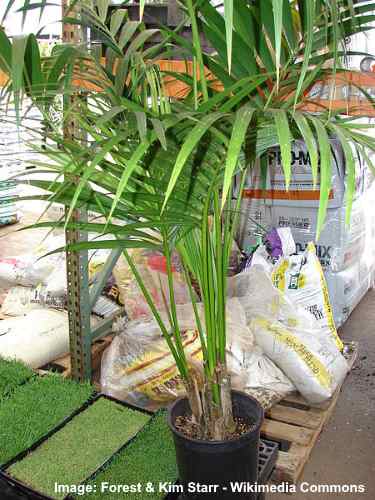
Indoor variants of the Kentia palm tree (Howea forsteriana) will reach a height of around 12 feet (3 meters) tall, while outdoor varieties might reach up to 40 feet (12 meters). They make an excellent choice to cultivate indoors because they are a slow-growing palm species.
The long palm-shaped leaves on the slender green stalks are perfect for adding a tropical feel to any space. Kentia palms are an ideal indoor palm because they can tolerate low light, little watering, little humidity, and chilly to warm temperatures.
Lady Palm Trees
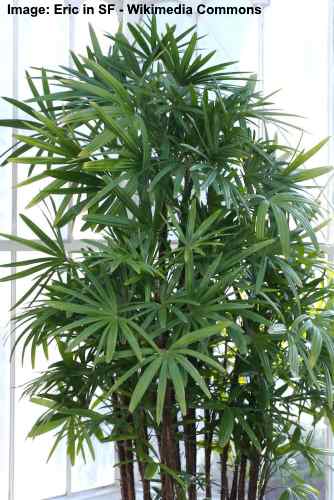
Broad-leafed Lady palms that can thrive indoors are known as Rhapis excelsa. This palm has a stunning bushy appearance and may reach a height of 13 feet (4 meters) when fully mature. The saw-tooth leaf tips on the palmate leaves are dark green and glossy. This palm has a lot of stems, which makes it look a lot like certain bamboo species indoors.
Ponytail Palm

One of the most beautiful indoor palms you can have in your room is the Ponytail palm tree (Beaucarnea recurvata). Bottle palm tree and elephant foot tree are two other common names for this plant.
It’s neither a palm nor a tree, but it has a ponytail. It’s a member of the Agave family and is actually a kind of succulent.
The thick brown swollen base of the Ponytail Palm’s stem distinguishes it from other palm species. The Elephant’s Foot Palm is also called that because of this distinguishing feature.
Areca palm (Dypsis lutescens)

The areca palm has three-foot (1 m) long arching fronds, yellow summer blooms, and little yellow-orange palm fruits. It is a multi-stemmed plant. Due to the numerous upward-curving stems of palm leaves, this palm has a distinct butterfly form. In tropical areas, the areca palm can grow up to 40 feet (12 meters) tall.
The palm’s growth habit and flowers are referred to by other common names for Dypsis lutescens. Bamboo palm, golden feather palm, cane palm, or yellow palm are all terms used to describe this palm.